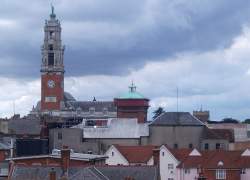 Tower of Colchester Town Hall, and in front to the right, the Water Tower.
Tower of Colchester Town Hall, and in front to the right, the Water Tower.
 Tower of Colchester Town Hall, and in front to the right, the Water Tower.
Tower of Colchester Town Hall, and in front to the right, the Water Tower.
The view of Colchester from a distance has two prominent buildings on the skyline – an enormous Victorian water tower, and the spire of the Town Hall. The latter, completed just within the Edwardian period, is decorated with architectural sculpture and is of interest to these pages. The third great building in the town is Colchester Castle, of great antiquity, being built on the still existing foundations of the Roman castle burnt down by Boadicea. The castle houses the local museum, and a second museum is just by it, called the Hollytrees Museum. Also in the town are the rather slight remains of a ruined priory, St Botolph’s, and among the various extant ecclesiastical buildings, St Peter Colchester is generally open and of interest.
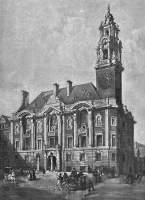
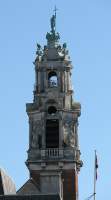 Colchester Town Hall, by John Belcher, and the tower.
Colchester Town Hall, by John Belcher, and the tower.
The Town Hall, by the architect John Belcher, was erected from 1898-1902, and thus spans the end of the Victorian era and the beginning of the Edwardian. The street position means that we tend either to see it from close by, obliquely, or the tower from further away, but cannot get a proper full-on view of the frontage. The frontage of the main block is Portland stone at ground and semi-basement levels, and red brick on the two higher levels, behind stone pillars and pediments, with stone edging round the rectangular windows and round-arched niches containing statues – four at the front, two round the side.
Eudo, Audley, Gilberd, and Harsnett, and round the side, Boadicea and Edward the Elder.
These statues, again in stone, are of personages connected with Colchester. First, Eudo, steward of William the Conqueror, involved in setting up of monastic orders – though here he is shown as a warrior with helmet, sword and shield; the sword, however, being placed point downwards so the hilt forms a cross, thus putting away of warlike things to turn to religious ones. Then Audley, styled as an Elizabethan merchant, in ruff, soft hat, and heavy, opulent robes. Gilberd – a Colchester born man who discovered electricity, again has a ruff, pantaloons, and cloak, and rests one hand on a ball on a pillar, presumably his device for collecting static electricity. And Harsnett, in priestly costume with mitre and crozier. Round the side, we have Boadicea, a Valkyrie-like figure, pointing with one hand, long spear in the other, who burned Colchester; and Edward the Elder, a Saxon king, rather less detailed in form than the other figures.
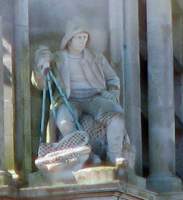
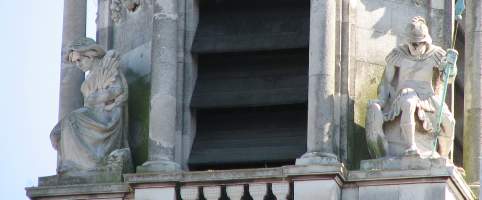
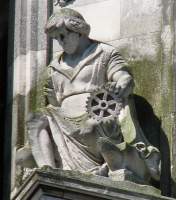 Tower statues - Colchester Fishery, Agriculture and Military Defence, and Engineering.
Tower statues - Colchester Fishery, Agriculture and Military Defence, and Engineering.
The tower, fashioned in baroque stages with pillars and open pediments, bears further figure sculpture. Above the balcony are four seated figures at the truncated corners. One is a figure of Agriculture, a girl holding a sheaf of corn, and wearing a hat decorated with flowers (for more allegorical figures of Agriculture, see this page). Traversing clockwise, we have a Roman soldier, with short spear, shield, and armour, an allegory of Military Defence. Next, a figure of Engineering, with a cockwheel, anvil etc, and finally a fisherman, with his nets, and wearing an all-weather coat and cowl, emblematic of the Colchester Fishery (for several more statues of fishermen, see the fish sculpture page).
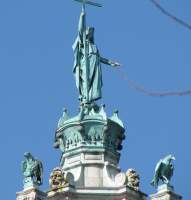 Summit with Empress Helena, and eagles.
Summit with Empress Helena, and eagles.
Higher still, at the summit corners above clustered pillars, are four eagles in greenish bronze – they are emblematic of the Port of Colchester, and were designed by F. Carruthers Gould – and behind them, grotesque lions’ heads. Finally, at the very top, is a standing, crowned female figure, also in bronze, holding a tall crucifix: she is the Empress Helena, patron saint of Colchester.
Above the main door – it is not quite grand enough on the scale of the building to be called a portico – is further architectural sculpture in a raised spandrel; a central coat of arms is flanked by two cherubic figures, and two spandrel girls, wearing crowns, open shirts, and long, diaphanous skirts. They face outwards from the curve of the arch, their bodies curved round so their heads look inwards, giving an elegant curve to each figure (lots more spandrel figures described on this page). The one holds a ship, the other a sheaf of corn (for more ship sculpture, see this page). Nicely formed, though many layers of paint have lost some of the detail, but there seems to be no signature, and I do not know who made these or the other sculpture on the building.
High above this central range, though not as high as the figures on the tower, is the Royal coat of arms, with grimacing lion and unicorn rearing up against it ( see this page for more such things).
A close examination of the building shows a variety of minor other adornments, three big stained glass windows, and some nice ironwork.
A strange, low castle with Italianate roofs, at first glance it looks all of a piece until a moment’s thought makes the casual visitor realise how unlikely the combination is. Eudo, whose statue we met on the Town Hall, started to build the edifice soon after the Norman conquest, but it was not completed until the turn of the century (i.e. 1100). The size of what is a single keep is extremely large – larger than any other castle keep in the British Isles, and a reason for this was that it was constructed on the foundations of the Roman Temple of Claudius. For an extra fee over the entrance charge, these still-existing foundations can be visited, and the castle as a whole makes much use of re-used Roman brick, rather like St Albans Cathedral.
The castle lasted well until the late 17th Century, when it was purchased by an entrepreneur who began to dismantle it from the top down to sell the stone for building purposes. Fortunately, at some point he was unable to turn a profit, and the lower storeys survived. In the early 18th Century, the castle passed into the hands of Charles Gray, the local MP, via his heiress wife, and he restored the castle to his own strange design – after a visit to Italy, where he saw Italianate roofs, he had the firm idea that Roman buildings had similar roofs, and determined that his castle would be capped in this manner. And hence the current building.
Inside is a rather impressive museum, with Roman mosaics and figurative work, medieval collections, and various 19th Century paintings and illustrations.
Next door to the castle is the Hollytrees Museum, free to enter, devoted to 18th and 19th Century works in the main, and including a room devoted to Arts and Crafts – with works by Mackmurdo and plates and vases by Evelyn de Morgan, two big fish bowls and smaller pieces by the Martin Brothers, and of most interest here, a copper disk by Thorwaldsen showing a Garden of Eden scene, rather splendid, naturalistic vegetative and animal life, with Adam and Eve central under tree, angels, deity, and on the outside, winged serpents.
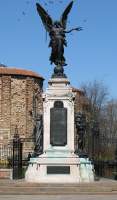
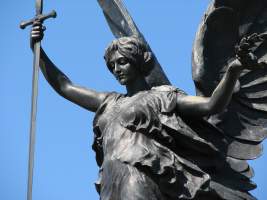 Colchester War Memorial by H. C. Fehr, and detail of Angel of Victory.
Colchester War Memorial by H. C. Fehr, and detail of Angel of Victory.
The First World War Memorial, by the sculptor H. C. Fehr, is one of the very best of its type, and consists of a tall limestone plinth, sculpted cherubic heads at the corners, with bronze memorial plaque at the front, female and male figures in bronze to the sides, and also in bronze, a summit angel. She is an Angel of Victory, shown alighting on the globe, carrying down-pointed sword and an open wreath, and wearing some diaphanous chiton or shift to reveal the soft contours of the body underneath. WW1 memorials are typically either late art nouveau to Edwardian, or a harder-edged forward looking type towards deco, and this memorial epitomises the former type, the contours of the angel being art nouveau, her hair being Edwardian. The female figure at the base, Peace, holding a dove aloft and about to fly, is even more turn of the century in spirit, with her gently swaying and languid pose. And the male figure, a St George, in his fantastical plate armour and holding a long, thin poignard, feels a creature of the decadent 90s. It is hard to think of a more perfect sculptural group than this. Fehr used similar figures elsewhere - see the page on him.
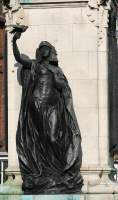
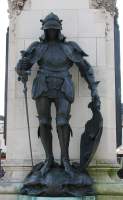 Figures of Peace and St George.
Figures of Peace and St George.
The Victorian Water Tower, which we noted as one of the most prominent features on the Colchester skyline along with the Town Hall, is of 1882, very bulky, seriously massive in brick; the architect was Clegg.
Among the various churches in the town, we should mention St Peter’s Church, because it is generally open, or has been when I have visited, and because it is on the way from the railway to the centre It is medieval, with rather a makeover in the mid-18th Century, and again in the later 19th Century, giving it a pleasing variety and a rather excellent exterior wall, gloomy and dark and characterful. Inside, there are a few decent wall monuments, and one 17th Century one with the usual pair of kneelers, facing each other over their desk, praying. Beneath, a panoply of smaller figures representing their children.
Finally, there remains in the centre of the town the fragmentary ruins of St Botolph’s Church and Priory, an antique Norman building of the late 11th Century. A tall wall with many arches, and some lesser walls survive, retaining a sombre elegance and as ever, a sense of keen regret that so much is lost and so little retained of what must once have been a grand building. The stonework is mingled with Roman brick, doubtless reused from the crumbling Roman ruins still in the neighbourhood at that time, so reminiscent of the walls of St Albans Abbey. The engravings show the structure from some years ago, when it was a little better preserved.
Sculpture pages // Sculpture in English towns
Visits to this page from 13 Mar 2014: 3,178 since 21 September 2024